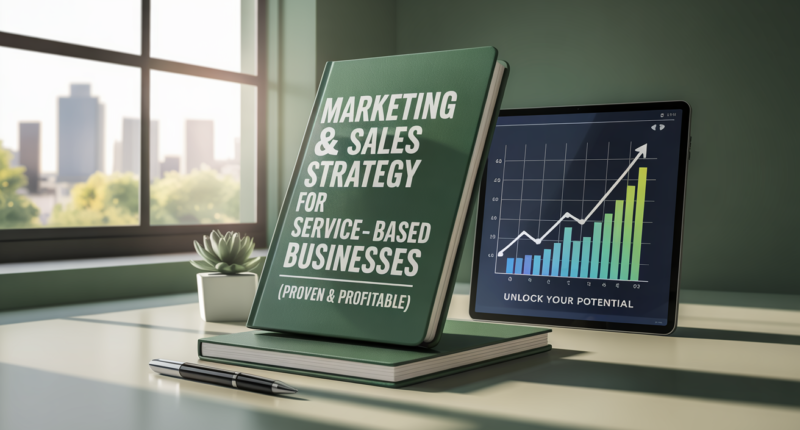First, remember that service businesses sell expertise more than products. For example, a consultant, therapist, or freelancer offers skills and solutions. Tailored marketing and sales strategies can attract loyal customers and build your brand . In addition, a clear plan helps. For instance, the U.S. Small Business Administration advises including your target market and your competitive edge in a simple marketing plan . By focusing on who you help and how you stand out, your efforts will be much more effective.
Identify Your Audience and Unique Value

-
First, define your ideal clients. Know who needs your service (age, location, interests) and what problem you solve for them. In fact, a marketing plan should start with your target market . This means studying the people most likely to hire you, so you can speak directly to their needs.
-
Next, highlight what makes you special. Service providers succeed by promoting unique skills and niche strengths . For example, a coach might focus on a certain method, or a stylist might specialize in curly hair care. Emphasize these skills in your messaging so customers know why to choose you.
-
Finally, build trust with branding. Create a clean, professional image: use a simple website, clear logo, and share your credentials or client results. As one expert advises, “create a professional website that showcases your expertise, certifications, and client testimonials” . A strong brand and social proof tell new clients that you are reliable and experienced.
Proven Marketing Tactics
-
Content and Visuals: Use videos and photos to show your work. For example, share short clips of a project or before-and-after photos of a service. Video “gives service providers a chance to share expertise in a personal, direct way,” and it can establish you as a thought leader . Likewise, as Squarespace notes, testimonials (reviews from happy clients) “give you a reputation boost and reassure customers that you’re trustworthy” . Include these on your website and social media.
-
Engage with Customers Online: Post regularly on social media and send email newsletters. An email newsletter “offers a chance to differentiate your business and continue building client relationships” . Share tips, behind-the-scenes, or special offers so people remember you. Also join relevant local Facebook or LinkedIn groups. In addition, network in person: word-of-mouth is powerful. Get involved in your community and local business groups . Happy customers talking about you and local partnerships can bring in steady leads.
-
Local Promotions and Referrals: Offer deals or referral rewards to get more business. For example, give a small discount for returning customers or a bonus to clients who refer friends. You can even set up a simple affiliate or loyalty program (like Orderry suggests, this can be “an excellent way to get more attention and traffic” ). Also list your services in local directories (Google My Business, Yelp, etc.) so nearby clients can find you easily.
Effective Sales Techniques
-
Educate on Value: When talking with prospects, focus on benefits. Don’t just describe what you do—explain how it solves their problem or saves them time. For instance, say how a repair saves money or how a service adds convenience. As one expert explains, people pay for outcomes, so “educating clients on the benefits, not functions of your services is the most important part” . This builds trust and makes the sale more natural.
-
Offer Packages and Deals: Make it easy to buy. Provide clear service packages or tiered options (like small, medium, large plans). For example, a writer might offer a basic article package and a premium content marketing plan. According to advice from Squarespace, pricing deals “are a great way to grow your customer base”squarespace.com. Bundling services or giving first-time discounts can bring in budget-conscious clients and upsell existing ones.
-
Follow Up and Reviews: Be proactive after first contact. Always follow up promptly—send an email or call leads who showed interest. After you complete a job, automate a follow-up email to thank the client and ask for a review . This not only helps get more referrals, but also shows professionalism. In other words, small but consistent touches like reminders and review requests turn satisfied clients into repeat buyers and sources of new clients.
-
Professional Image and Communication: First impressions matter. Dress neatly, be punctual, and communicate clearly. Good manners, a firm handshake, and explaining steps simply will make clients feel comfortable. Remember that “good hygiene, a firm handshake, and eye contact are universal signs of professionalism”rehash.tech. A polished, friendly approach makes customers more likely to hire you and recommend you to others.
Track Progress and Adjust
Regularly check what’s working. Keep simple records of your marketing and sales results. For example, note which ad brought a lead or track referrals. The SBA recommends comparing your marketing costs to the sales they bring so you get a positive return on investmentsba.gov. In practice, this means asking “Where did you hear about us?” and tracking spend. Also use basic data: a small CRM or even a spreadsheet can log leads and sales. As one service-business expert notes, the data from leads and conversions will show “what’s working and what’s not” . Use these insights to focus on the strategies that bring the most profit.
In summary, successful service businesses combine client-focused marketing with smart sales tactics. By defining your target audience, emphasizing your unique skills, and consistently building trust, you can draw in more clients. Additionally, clear sales techniques—such as educating customers and following up—help turn interest into profit. Remember, small service firms thrive on strong relationships: solve your clients’ problems first, and profits will follow. With these proven strategies and a bit of patience, small business owners and freelancers can grow a steady, profitable service business .









